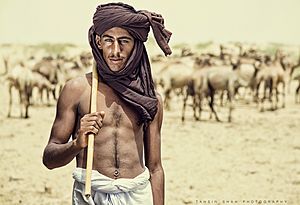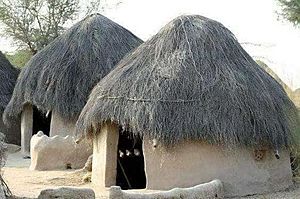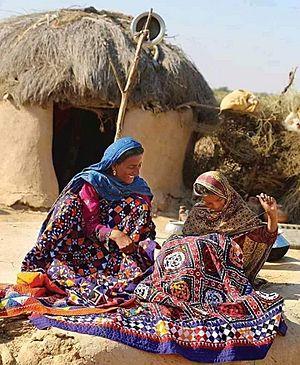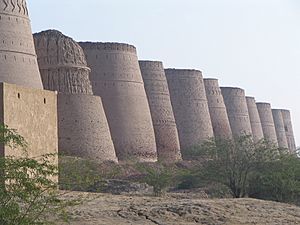Cholistan Desert facts for kids
Quick facts for kids Cholistan Desert |
|
|---|---|
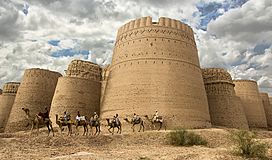
Derawar Fort is the best surviving example of the forts which used to guard desert caravan routes.
|
|
| Geography | |
| Location | Punjab , Rajasthan |
| Country | Pakistan , India |
| State | Punjab , Rajasthan |
| Region | Punjab region , Rajasthan |
| Borders on | Pakistan India |
The Cholistan Desert (Urdu: صحرائے چولستان; Punjabi: چولستان روہی), also known as Rohi, is a large desert in the southern part of Punjab, Pakistan. It is part of the bigger Thar Desert, which reaches into Sindh province and the Indian state of Rajasthan. Cholistan is one of two major deserts in Punjab, the other being the Thal Desert. The name "Cholistan" comes from the word chol, meaning "sands," and istan, meaning "land of." So, it means "Land of Sands."
Long ago, Cholistan was an important place for trading caravans. Many forts were built during the medieval period to protect these trade routes. The Derawar Fort is the best example of these old forts that still stands today.
Contents
Exploring the Cholistan Desert
Cholistan covers a huge area of about 25,800 km2 (10,000 sq mi). It stretches across the Bahawalpur, Bahawalnagar, and Rahim Yar Khan areas in southern Punjab. The closest big city is Bahawalpur city, which is about 30 km (19 mi) from the desert's edge. The desert is about 480 kilometers long and its width changes from 32 to 192 kilometers. Most of the desert (81%) is sandy, while the rest has flat areas and small sand dunes. The desert is always changing because of wind erosion, which means the wind blows away the soil, especially where there isn't much plant cover.
Weather in Cholistan
The weather in Cholistan is very dry and hot, like a Tropical desert. It has very low humidity all year. The average temperature is about 28.33 °C (82.99 °F). July is the hottest month, with an average temperature of 38.5 °C (101.3 °F). In summer, temperatures can go above 46 °C (115 °F), and sometimes even over 50 °C (122 °F) during very dry periods. In winter, temperatures can sometimes drop to 0 °C (32 °F).
Cholistan usually gets up to 180mm of rain each year, with most rain falling in July and August. However, droughts (long periods with no rain) are very common. People collect water in natural pools called Toba or man-made pools called Kund. Water found deep underground (30–40 meters down) is usually salty and not good for most plants.
Water Challenges
In May 2022, the Cholistan desert faced a big challenge due to extreme heat and a lack of water. This made it very difficult for animals, especially cattle and sheep, to survive. Many shepherds and their animals had to move from areas where water was scarce. This event highlighted the ongoing struggle for water in this dry region.
How Cholistan Was Formed
The Cholistan Desert was formed during the Pleistocene period, which was a very long time ago. Geologists divide Cholistan into two main parts: Greater Cholistan and Lesser Cholistan. These two parts are generally separated by the dry bed of an ancient river called the Hakra River.
- Greater Cholistan is mostly sandy. It's in the southern and western parts of the desert, reaching up to the border with India. This area covers about 13,600 km2 (5,300 sq mi). The sand dunes here can be over 100 meters tall! The soil in this part is also very salty.
- Lesser Cholistan is a bit less sandy and covers about 12,370 km2 (4,780 sq mi). It stretches north and east from the old Hakra river bed, historically reaching the Sutlej River. The soil quality here is generally poor, with little organic matter in Greater Cholistan and compacted clay in Lesser Cholistan. A canal system built during the British era helped bring water to the northern part of Lesser Cholistan for farming.
A Look Back in Time
Even though Cholistan is a dry region now, a large river once flowed through it. This river was formed by the waters of the Sutlej and Yamuna Rivers. The dry bed of the Hakra River still runs through the area. Along this old riverbed, many ancient settlements from the Indus Valley civilization (also known as the Harappan culture) have been found. One of these is a large ancient city called Ganweriwal.
This river system supported many communities between 4000 BCE and 600 BCE, until the river changed its path. The river carried a lot of water and flowed at least as far as where Derawar Fort is today. In the 1970s and 1990s, over 400 Harappan sites were found in Cholistan. This high number of settlements suggests that Cholistan might have been one of the most productive areas of the Indus Valley Civilization. After the Harappan period, Cholistan was home to the Cemetery H culture and later the Painted Grey Ware culture.
The region became a hub for caravan trade. This led to the building of many forts during the medieval period to protect the traders and their goods. The Derawar Fort is the best-preserved example of these forts. Other large forts in Cholistan include Meergarh, Jaangarh, Marotgarh, Maujgarh, Dingarh, Khangarh, Khairgarh, Bijnotgarh, and Islamgarh. The word "garh" means "fort." These forts are being considered for the UNESCO World Heritage Sites list. They run roughly parallel to the Indus and Sutlej Rivers, about 40 miles to the south. Smaller forts in the area include Bara, Bhagla, Duheinwala, Falji, Kandera, Liara, Murid, Machki, Nawankot, and Phulra forts.
Life and Work in Cholistan
The economy of Cholistan mainly depends on raising animals. There are not many other ways to earn a living here, especially away from the irrigated parts of Lesser Cholistan, because there isn't a steady water supply for farming.
Animal Rearing
Camels are especially important in Cholistan. People value them for their meat and milk, for carrying goods, and for fun activities like racing and camel dancing. There are two main types of camels in Cholistan:
- Marrecha or Mahra camels are used for transportation, racing, or dancing.
- Berella camels are raised for milk and can produce 10–15 liters of milk per day.
Animals are the main source of wealth for the nomadic people of Cholistan. They breed cattle to sell, milk them, or shear them for their wool. Because they live in isolated areas, they have learned to make almost everything they need, like food, clothes, and daily items. Later, they started selling their goods to other places. It's estimated that there are about 1.6 million livestock animals in the desert areas.
Crafts and Textiles
Cholistan is known for producing very good quality carpet wool, better than in many other parts of Pakistan. From this wool, people knit beautiful carpets, rugs, and other woolen items. This also includes warm blankets, which are essential because winter nights in the desert can be very cold, often below freezing.
They also make Khes and pattu from wool or cotton. Khes is a type of blanket with black and white patterns, while pattu has a white base. Today, Cholistan sells a lot of its wool because it brings good profit.
Cotton textiles have always been a special craft in the Indus Valley. Various kinds of khaddar cloth are made for local use, including fine khaddar bedclothes and coarse lungies. A beautiful cloth called Sufi is woven from silk and cotton, or with cotton threads and silk wool. Gargas are made with many patterns and colors, featuring detailed embroidery, mirrors, and patchwork.
Ajrak is another unique craft from Cholistan. It's a special printing technique that applies indigo blue and red patterns to both sides of the cloth. Cotton turbans and shawls are also made here. Chunri is another type of scarf, with countless colors and patterns like dots, squares, and circles.
The People of Cholistan
According to the 1998 Census of Pakistan, about 128,019 people lived in Cholistan. By 2015, this number was estimated to be around 229,071, with 70% living in Lesser Cholistan. The average household has about 6 to 7 people.
Local Crafts and Art
The Indus Valley has long been home to wandering nomadic tribes who prefer isolated areas. These areas allow them to live freely and develop their own unique cultures without much outside interference. Until the time of the Mughal Empire, Cholistan was quite isolated. During the rule of Mughal Emperor Akbar, it became a more productive region. The area was ruled by kings who protected their borders. These rulers supported art, which led to the development of many crafts at the same time. Masons, stone carvers, artists, and designers helped rebuild old cities and create new sites. This also led to new styles in court paintings, weaving, and pottery. Architecture, sculpture, and pottery greatly improved during this period.
Camel Products
Camels are very important to the people living in the desert. They are not just useful for transport and carrying loads; their skin and wool are also very valuable. Camel wool is spun and woven into beautiful woolen blankets called falsies and strong, stylish rugs. Camel leather is used to make caps, goblets, and fancy lampshades.
Leather Work
Leather work is another important local craft because there are so many livestock animals here. Besides the products mentioned above, Khusa (shoes) are a specialty of this area. Cholistani khusas are famous for their excellent quality, variety, and rich designs, especially when they are stitched and embroidered with gold or bright threads.
Jewelry
The people of Cholistan love jewelry, especially gold jewelry. The main ornaments they make and wear include Nath (a nose ring), Katmala (a necklace), Kangan (a bracelet), and Pazeb (anklets). Gold and silver bangles are also made in Cholistan. Locals also work with enamel, creating colorful enamel buttons, earrings, bangles, and rings.
Nature in Cholistan
Plants
The water found deep underground in Cholistan is usually salty, which means most plants can't grow well there. The native trees, shrubs, and grasses are special because they can survive with very little water. There are 131 different types of plants in Cholistan. Some of the most common ones are:
- Prosopis cineraria
- Haloxylon salicornicum
- Cenchrus ciliaris
A special man-made forest called Dingarh was created by the Pakistan Council of Research in Water Resources (PCRWR). It covers over 100 hectares. They fixed and stabilized sand dunes using both machines and plants. Now, the area is covered with trees, and there are orchards of zizyphus (jujube), date palms, and grasslands. These plants grow using collected rainwater and salty groundwater.
Animals
The wildlife in the Cholistan desert mostly includes birds that migrate there, especially the Houbara bustard. These birds come to this area during winter. They are popular during hunting season, even though they are endangered in Pakistan and considered vulnerable worldwide by the IUCN Red List. Their numbers have dropped a lot over the years.
A few other endangered animals in this desert are the Chinkara Antelope, Great Indian Bustard, and Blue Bull. The population of Chinkara has also decreased significantly due to hunting without permits.
Famous Forts in Cholistan
- Derawar Fort
- Islamgarh Fort
- Mirgarh Fort
- Jamgarh Fort
- Mojgarh Fort
- Marot Fort
- Phoolra Fort
- Khangarh Fort
- Khairgarh Fort
- Nawankot Fort
- Bijnot Fort
Terracotta Art
The Indus civilization was one of the first places where pottery was made, so the pottery of Cholistan has a very long history. The local soil is very fine and perfect for making pottery. You can see how fine the earth is on the local mud houses, which look almost whitewashed even though they are just plastered with mud. The main ceramic items from Cholistan are their surahies (water pitchers), piyalas (bowls), and glasses, which are known for being light and having a smooth finish.
In earlier times, only pottery and terracotta art developed. But from the seventh century onwards, many temples and statues were also built. This happened because religious feelings grew stronger and cities became wealthier.
See also
 In Spanish: Desierto de Cholistán para niños
In Spanish: Desierto de Cholistán para niños
- Khes


